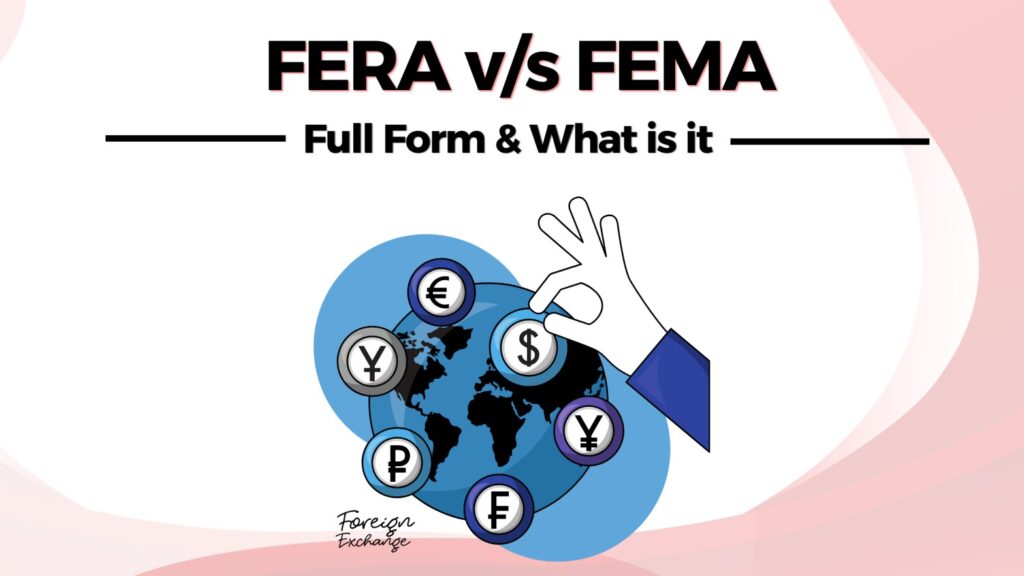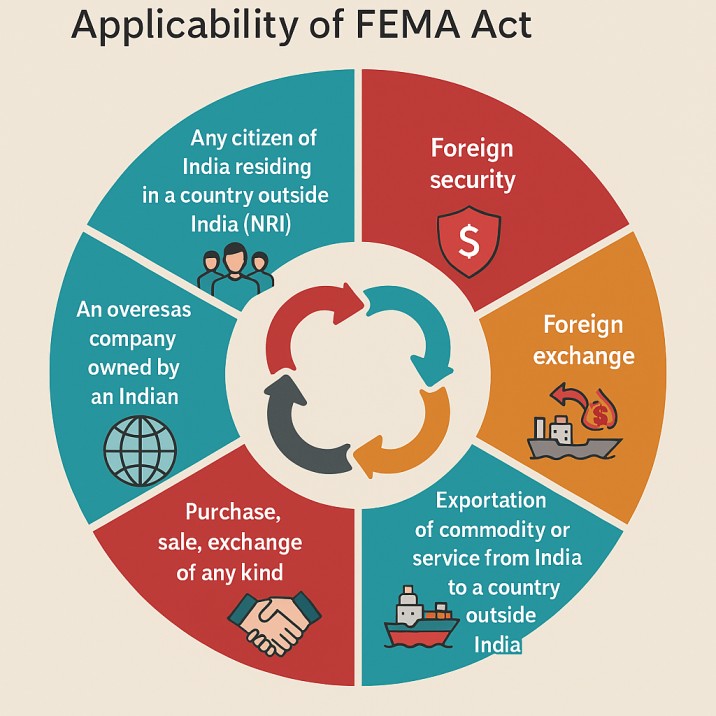
Imagine a time when strict rules controlled every rupee that moved in or out of India. Businesses struggled, foreign investments were restricted, and the economy felt locked up. This was the era of FERA (Foreign Exchange Regulation Act), a law meant to control foreign exchange in India. But as the country opened its doors to globalization, FERA was replaced by a more flexible and business-friendly law – FEMA (Foreign Exchange Management Act).
So, why did India shift from FERA to FEMA? What was wrong with the old system, and how did the new one change the game? If you’re curious to know the difference between FERA and FEMA, how they impact businesses, and why this transition was necessary, keep reading!
Foreign exchange—or Forex or FX—is the system that lets countries trade their currencies. You see when you travel from India to the USA, you can't just use Indian rupees (INR) there. You need to exchange them for US Dollars (USD). Businesses and governments do the same for trade, investments and economic growth. That exchange of currencies is what we call foreign exchange.
Governments regulate it because if they don't, a country's currency can lose value due to too many uncontrolled foreign transactions, black money movements or economic instability. India's laws, such as FERA and FEMA, were put in place to manage and protect the economy. FERA was quite strict and restrictive, while FEMA made foreign transactions smoother. That helped India integrate with the global economy more easily.
FERA stands for the Foreign Exchange Regulation Act, which was introduced in 1973 to regulate foreign exchange transactions in India strictly. FEMA stands for the Foreign Exchange Management Act, which replaced FERA in 1999. Unlike FERA, FEMA focuses on managing and facilitating foreign exchange transactions rather than restricting them.
The Foreign Exchange Regulation Act (FERA) was enacted in 1973 to regulate foreign exchange and conserve India’s limited foreign reserves. At that time, India faced a shortage of foreign currency, and the government wanted strict control over international financial transactions. FERA aimed to restrict foreign investments, regulate dealings in foreign currency, and prevent the misuse of foreign exchange.
It had 81 sections and covered various aspects of currency conversion, fund transfers, overseas property purchases, and dealings with non-residents. The Reserve Bank of India (RBI) had the power to enforce FERA, and any violations could result in severe penalties, asset seizures, or imprisonment.
Key Features of FERA:
Despite its goal of protecting India's economy, FERA became a major obstacle to foreign trade and investments. Its rigid policies led to economic restrictions, making business expansion difficult. Recognizing these challenges, the Indian government replaced FERA with the Foreign Exchange Management Act (FEMA) in 1999, bringing in a more flexible and business-friendly system.
Also Read: What is CE and PE in the Stock Market?
The Foreign Exchange Management Act (FEMA) was enacted in 1999, replacing the strict and outdated Foreign Exchange Regulation Act (FERA). FEMA was introduced as part of India's economic liberalization to promote foreign trade, investment, and economic growth. Unlike FERA, which focused on restricting foreign exchange transactions, FEMA aimed at managing and facilitating them in a structured and transparent manner.
The Act consists of 49 sections and provides a legal framework for foreign currency transactions, cross-border trade, and international financial dealings.

Key Features of FEMA:
FERA was a strict law focused on controlling foreign transactions, whereas FEMA replaced it with a more flexible and business-friendly framework. While FERA imposed harsh penalties for violations, FEMA took a management-oriented approach, smoothing foreign trade and investments.
| Feature | FERA (Foreign Exchange Regulation Act) | FEMA (Foreign Exchange Management Act) |
|---|---|---|
| Enactment Year | 1973 | 1999 |
| Purpose | Restrict and control foreign exchange transactions | Manage and facilitate foreign exchange transactions |
| Approach | Rigid and strict | Liberal and flexible |
| Number of Sections | 81 | 49 |
| Regulating Authority | Reserve Bank of India (RBI) and Enforcement Directorate | Reserve Bank of India (RBI) |
| Applicability | Applied to Indian citizens and foreign companies operating in India | Applied to all residents of India, including foreign entities doing business in India |
| Approval Requirement | Foreign exchange transactions needed strict RBI approval | Transactions are permitted unless specifically restricted |
| Penalty for Violation | Lower, simplified procedures make compliance easier | Criminal offence with heavy fines and imprisonment |
| Business Friendliness | Discouraged foreign investments and trade | Encourages foreign direct investment (FDI) and international trade |
| Compliance Burden | High; strict regulations made compliance difficult | Lower; simplified procedures make compliance easier |
FERA was replaced by FEMA in 1999 because the Indian economy had evolved, and the old law no longer suited the country’s growing needs. FERA was introduced in 1973 when India had limited foreign reserves and needed strict control over foreign exchange. However, as India moved towards economic liberalization in the 1990s, these rigid restrictions became a roadblock to progress.
Here’s why FERA was replaced:
In short, FERA was a law of restrictions, while FEMA is a law of regulation and facilitation. This shift helped India integrate with the global economy and encourage foreign investments.
Also Read: What is BO ID in CDSL & How to Find it?
The transition from FERA to FEMA had a significant impact on India’s economy, shaping its growth and global position. Here’s how:
Overall, FEMA helped India shift from a closed economy to a globally competitive one, making it a preferred destination for trade and investment.
The basic difference between FERA and FEMA is their approach to foreign exchange regulation. FERA was strict and focused on restrictions, making it difficult for businesses to engage in international trade. On the other hand, FEMA is a more flexible and business-friendly law, allowing smoother foreign transactions and encouraging foreign investments. With simplified compliance and a transparent legal framework, FEMA has helped India align with global economic standards.
The full form of FERA is Foreign Exchange Regulation Act, and FEMA stands for Foreign Exchange Management Act. FERA was enacted in 1973 to regulate foreign exchange transactions in India, while FEMA replaced it in 1999 with a more flexible and business-friendly approach.
FERA was a law designed to control and restrict foreign exchange transactions, making it difficult for businesses to operate internationally. FEMA, on the other hand, was introduced to manage and facilitate foreign exchange, allowing smoother foreign trade and investment while maintaining regulatory oversight.
The basic difference between FERA and FEMA is that FERA imposed strict regulations and criminal penalties on foreign exchange violations, whereas FEMA is more flexible and treats violations as civil offenses. FERA aimed to conserve foreign exchange reserves, while FEMA focuses on efficiently managing foreign transactions in line with global financial standards.
Yes, FEMA is still in effect in India. It continues to regulate foreign exchange transactions, ensuring compliance with RBI guidelines. FEMA has replaced FERA’s strict controls with a liberalized legal framework, making foreign transactions easier for businesses and individuals while preventing money laundering and illegal forex activities.
FEMA has had a positive impact on foreign investors, making India a more attractive destination for foreign direct investment (FDI). Unlike FERA, which imposed heavy restrictions, FEMA simplifies foreign exchange policies, reduces bureaucratic delays, and ensures easier repatriation of funds, thereby encouraging global businesses to invest in India.
Disclaimer: This article is for educational purposes only and should not be considered financial advice. Always conduct your research and consider consulting with a financial advisor before making any investment decisions.